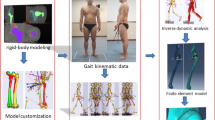Abstract
Hip mechanical simulation for estimating pressures within the soft tissues during the loads and motions of daily activities is a common approach to investigate hip joint pathology. Many computational approaches estimate the pressure and contact pressures via finite element methods (FEM) by using 3D meshes of the tissues. Although this type of simulation can provide a good evaluation of hip problems, the process may be very time consuming and unsuitable for fast medical hip simulations. In this chapter, a statistical model is proposed for estimating hip pressures during its movement, by using the geometrical features extracted from 3D meshes of different hip models. The method is tested by examining 25 different hip models during a frequent daily activity.
Access this chapter
Tax calculation will be finalised at checkout
Purchases are for personal use only
Similar content being viewed by others
References
Arbabi E, Boulic R, Thalmann D (2007) A Fast Method for Finding Range of Motion in the Human Joints. In: Proc of Int Conf of the IEEE Eng in Medicine and Biology Society, pp. 5079–5082
Bergmann G, Deuretzbacher G, Heller M, Graichen F, Rohlmann A, Strauss J, Duda GN (2001) Hip contact forces and gait patterns from routine activities. J Biomech 34:859–871
Bizzini M, Notzli HP, Maffiuletti NA (2007) Femoroacetabular impingement in professional ice hockey players: A case series of 5 athletes after open surgical decompression of the hip. Am J Sports Med 35(11):1955–1959
Chegini S, Beck M, Ferguson SJ (2006) Femoro Acetabular Impingement as a Possible Initiator of Cartilage Degeneration. In: Proc of Int Symp on Comp Meth in Biomech & Biomed Eng, pp. 705–710
Chegini S, Beck M, Ferguson SJ (2008) The effects of impingement and dysplasia on stress distributions in the hip joint during sitting and walking: A finite element analysis. J Orthop Res 27(2):195–201
Ferguson SJ, Bryant JT, Ito K (2001) The material properties of the bovine acetabular labrum. J Orthop Res 19:887–896
Genoud P, Sadri H, Dora C, Bidaut L, Ganz R, Hoffmeyer P (2000) The hip joint range of motion: A cadaveric study. In: Conf of the European Society of Biomechanics
Gilles B, Moccozet L, Magnenat-Thalmann N (2006) Anatomical Modelling of the Musculoskeletal System from MRI. In: MICCAI, pp. 289–296
Hodge WA, Fijan RS, Carlson KL, Burgess RG, Harris WH, Mann RW (1986) Contact pressures in the human hip joint measured in vivo. In: Proc Natl Acad Sci (83), pp. 2879–2883
Kang M, Sadri H, Moccozet L, Magnenat-Thalmann N (2003) Hip Joint Modeling for the Control of the Joint Center and the Range of Motions. In: Proc of IFAC Symp on Modeling and Control in Biomedical Systems, pp. 20–24
Malhi A, Gao RX (2004) PCA-based feature selection scheme for machine defect classification. IEEE Trans Instrum Meas 53(6):1517–1525
Mardones RM, Gonzalez C, Chen Q, Zobitz M, Kaufman KR, Trousdale RT (2005) Surgical treatment of femoroacetabular impingement: Evaluation of the effect of the size of the resection. J Bone Joint Surg 87-A:273–279
Miller EH, Schneider HJ, Bronson JL, McLain D (1975). A new consideration in athletic injuries. The classical ballet dancer. Clin Orthop Relat Res 111:181–191
Moglo KE, Shirazi-Adl A (2003) On the coupling between anterior and posterior cruciate ligaments, and knee joint response under anterior femoral drawer in flexion: A finite element study. Clin Biomech 18:751–759
Notzli HP, Wyss TF, Stoecklin CH, Schmid MR, Treiber K, Hodler J (2002) The contour of the femoral head-neck junction as a predictor for the risk of anterior impingement. J Bone Joint Surg Br 84:556–560
Russell ME, Shivanna KH, Grosland NM, Pedersen DR (2006) Cartilage contact pressure elevations in dysplastic hips: a chronic overload model. J Orthop Surg 1(6):1–11
Solidworks 2005, Solidworks Corp., Boston, MA, USA
Theodoridis S, Koutroumbas K (2003) Pattern Recognition. Academic Press, CA
Wiberg G (1939) Studies on dysplastic acetabular and congenital subluxation of the hip joint: With special reference to the complication of osteo-arthritis. Acta Chir Scand 58:7–38
Acknowledgments
This research has been supported by the NCCR Co-Me (Computer-Aided and Image-Guided Medical Interventions) of the Swiss National Science Foundation.
Author information
Authors and Affiliations
Corresponding author
Editor information
Editors and Affiliations
Rights and permissions
Copyright information
© 2009 Springer-Verlag London
About this chapter
Cite this chapter
Arbabi, E., Chegini, S., Boulic, R., Ferguson, S.J., Thalmann, D. (2009). Estimating Hip Joint Contact Pressure from Geometric Features. In: Magnenat-Thalmann, N., Zhang, J., Feng, D. (eds) Recent Advances in the 3D Physiological Human. Springer, London. https://doi.org/10.1007/978-1-84882-565-9_11
Download citation
DOI: https://doi.org/10.1007/978-1-84882-565-9_11
Published:
Publisher Name: Springer, London
Print ISBN: 978-1-84882-564-2
Online ISBN: 978-1-84882-565-9
eBook Packages: Computer ScienceComputer Science (R0)




